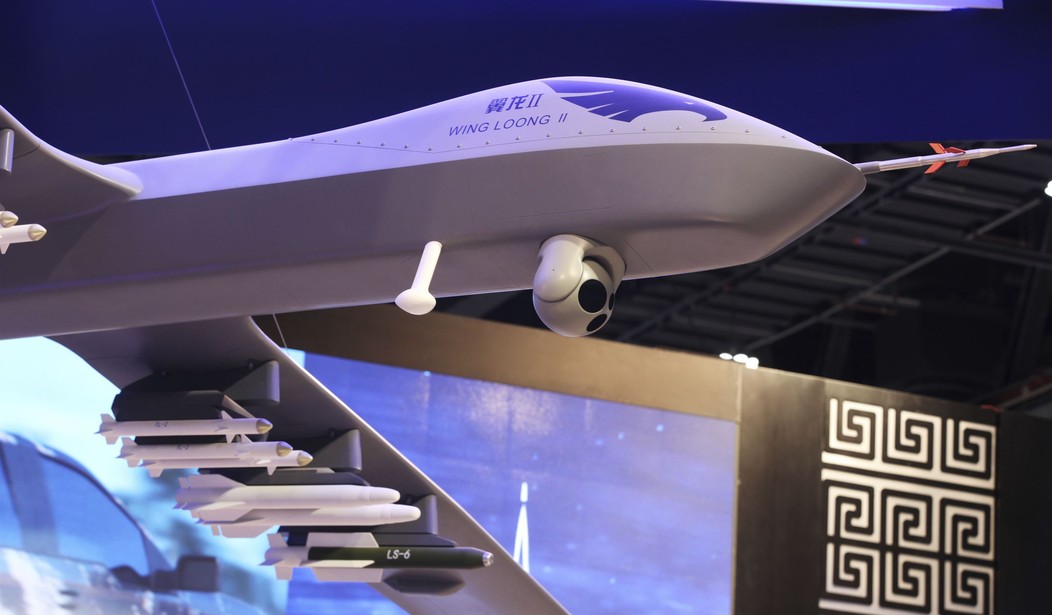Not quite yet, but the Game Of Drones that has nat-sec thinkers obsessing over potential doomsday scenarios may not last long.
As anyone who studies weapons development knows, an advance on offense usually means an innovation on defense will come soon after. After watching Russia and Iran make heavy use of drones in warfare, everyone suddenly began discussing an American "drone gap" in future combat situations. Defense Secretary (wisely) put resources into innovation and development of offensive capability, but also to find ways to negate it. Axios reports today that a new electromagnetic system appears to negate the advantages of low-altitude drone warfare, at least in its first real-world testing phase:
Defense contractor Epirus this week demonstrated its drone-frying Leonidas to observers from various U.S. military services and foreign countries, including some in the Indo-Pacific.
- Axios was the only media on hand for the Atterbury tests, about 45 minutes south of downtown Indianapolis.
- In the climax of the two-hour show, Leonidas went up against 49 quadcopters, among the largest grouping it's ever faced. The "forcefield system," which weaponizes electromagnetic interference, crippled all of them at once. No pricey projectiles. No fireballs.
- Epirus CEO Andy Lowery was understandably bullish, telling Axios: "I call this a singularity event."
Hey, wait a minute. I've seen this movie before!
Well ... I didn't say it was a good movie.
However, this is probably a decent conceptual depiction of what Epirus has in mind with its counter-drone system. Think of it as an Iron Dome or Patriot system, only adapted for drones rather than ballistic missiles, and without any need for precise targeting. By using an electromagnetic pulse (EMP), the Leonidas system disables dozens or perhaps hundreds of drones well before they can reach their targets. If this proves effective, it would essentially neuter the cost and nimbleness factors that make drone warfare so attractive at the moment. If this system could be adapted to airborne platforms safely -- as in, not disabling the aircraft carrying it -- it could do even more damage to offensive arms systems.
Of course, the Leonidas test results should come with a few caveats. First off, the Axios report suggests that the test involves commercially available quadcopters rather than military-grade hardware. Even 40 years ago, when I worked in the defense industry, the Pentagon required defense systems to use EMP-resistant circuitry, as any kind of nuclear warfare would involve atmospheric EMP surges that would cripple commercial-grade electronics. Leonidas would still be useful if it only went after lower-grade drones as defense systems for airports, where malefactors could interfere with commercial and military aviation. It still remains to be seen whether this would work against military-grade drones, especially those traveling at higher speeds.
There is also the question of power sourcing in battlefield conditions. An EMP system would require enormous amounts of readily available electricity. Presumably, the Leonidas system would be mobile rather than fixed, or else the first target of the drones would be Leonidas installations -- just as in any other doctrine for air offensives, which takes out anti-aircraft systems first. (Just ask the Iranians about that.) How do you get that much power to mobile systems under combat conditions? One advantage of Iron Dome/Patriot/THAAD field systems and their "pricey projectiles" is that they can operate on their own with local generators and batteries. Producing an EMP for this kind of effect would almost certainly need more power than batteries and/or generators could provide, especially for multiple bursts. (One thought: the US Navy might take a very keen interest in such systems, as they could easily provide power to a Leonidas-type EMP defense system on surface ships.)
Those concerns shouldn't outweigh the enthusiasm for the potential of the Leonidas system, though. Even if it can't provide a complete defense, it will likely be much less costly than current anti-drone systems that require constant materiel replenishment (assuming power can be found cheaply). It could be layered into current anti-drone doctrines and used in combination with other defense systems. If it turns out to be as successful against military-grade drones as this test suggests, it will make drone warfare significantly more expensive in the near future, and with that cost, that form of offensive operation will perhaps lose some of its appeal.
In the meantime, we can at least begin using some of these defensive capabilities around sensitive installations in the US and abroad, as well as on naval ships. That will provide an income stream to innovators who will find ways to overcome the gaps in EMP-based drone defense. It will also serve to remind us that warfare innovation works rapidly to negate advantages in others' innovation, and sometimes even the most modern doctrine may not last forever.
Editor's Note: Thanks to President Trump and Defense Secretary Pete Hegseth's leadership, the warrior ethos is coming back to America's military.
Help us report on Trump and Hegesth's successes as they make our military great again. Join Hot Air VIP and use promo code FIGHT to get 60% off your membership!








Join the conversation as a VIP Member